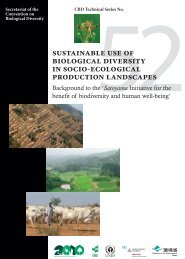INDIAN SCIENCE CONGRESS - India Environment Portal
INDIAN SCIENCE CONGRESS - India Environment Portal
INDIAN SCIENCE CONGRESS - India Environment Portal
You also want an ePaper? Increase the reach of your titles
YUMPU automatically turns print PDFs into web optimized ePapers that Google loves.
18<br />
Proc. 98th <strong>India</strong>n Science Congress, Part II : Presidential Address<br />
September, some may last up to mid of October, This is primarily based upon the<br />
inhabitant and communication of the rainy season in this zone 30 species of macro<br />
fungi were seen to form mycorrhizal will different tree species viz. II species were<br />
associated with C. deodara, 7 with Q. leucotrichophora 4 with Picea smithiana<br />
and P. roxburghii three with P. wallichiana, two with Quercus semicarpifolia<br />
and one each with Rhododendron arboreum and Betula sp.<br />
(2) Ecological relationships of Morels<br />
The relation of Morchella production to forest type, the fruiting period of<br />
morels plus such parameters as temperature, pH and NPK and Ca contents of<br />
morel bearing and non morel bearing soils have also been investigated. The<br />
maximum production of Morchella has been observed to be in the temperate mixed<br />
coniferous forests especially in deodar forests, from March to May, depending upon<br />
the amount of snowfall and subsequent precipitation.<br />
The Mycorhhizosphere of morels bearing soils and non- morel bearing soils<br />
was also studied to identify the associated fungi. Morchella esculenta, M. conica,<br />
M. angustceps and M. deliciosa have been observed to enter into mycorrhizal<br />
association with herbaceous plants i. e. strawberry, ferns and grasses. The<br />
subterranean portion of the capophore forms a loosely woven cord near its base.<br />
Morel hyphae penetrate into all the tissues of roots except xylem. The hyphae form<br />
a loose weft on the root periphery, some of them penetrating directly into the cell<br />
lumens (Lakhanpal et al. 1991) : The entire work on morels has been processed<br />
into a monograph entitled, “Biology of <strong>India</strong>n Morels” (Lakhanpal et. al. 2010).<br />
Mushrooms and <strong>Environment</strong>al Amelioration<br />
The present times witness a tremendous increase in the generation of wastes.<br />
Mushroom cultivation can be practiced to recycle some of the waste material. The<br />
processes of mushroom cultivation can bio convert all the major plant polymers.<br />
Bio-conservation of waste through mushroom cultivation is simple and low cost<br />
technology. In this process, enzyme complexes of mushroom act upon the lignocellulosic<br />
material degrading and utilizing it to produce mushroom fruiting bodies with<br />
high value food protein, which can be directly consumed by human beings. The<br />
residues can also be used as animal feed or as an effective soil fertilizer.<br />
From amongst the 2000 species of mushrooms reported to be edible from all<br />
over the world, technology is available for the commercial cultivation of about 14<br />
species. We were also able to develop cultivation technology for two mushrooms.
















